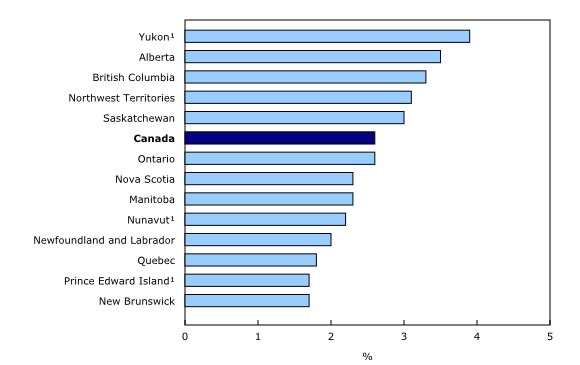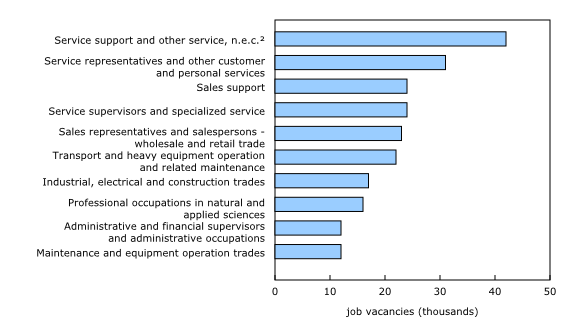Job Vacancy and Wage Survey, first quarter 2015
Archived Content
Information identified as archived is provided for reference, research or recordkeeping purposes. It is not subject to the Government of Canada Web Standards and has not been altered or updated since it was archived. Please "contact us" to request a format other than those available.
Released: 2015-08-13
There were almost 400,000 job vacancies in Canada and the job vacancy rate was 2.6% in the first quarter—as indicated by a new survey conducted in early 2015.
This is the first release of the Job Vacancy and Wage Survey (JVWS). This release draws on data from the job vacancy component of this survey, with information on job vacancies by occupation, province, territory and economic region. (See the note to readers for information about this new survey and how it was conducted).
Job vacancy rates across Canada
In general, Western Canada had higher job vacancy rates than did Central and Eastern Canada. Yukon (3.9%), Alberta (3.5%), and British Columbia (3.3%) had the highest job vacancy rates, while New Brunswick and Prince Edward Island (both at 1.7%) had the lowest rates for the first quarter.
The job vacancy rate refers to the share of jobs that are unfilled out of all payroll jobs available. It represents the number of job vacancies expressed as a percentage of labour demand; that is, the sum of all occupied and vacant jobs.
Among the 76 economic regions in Canada, the 10 economic regions with the highest job vacancy rates were in the western provinces or in Yukon. Looking at the 10 economic regions with the lowest job vacancy rates, 7 were in Quebec.
There were exceptions to this general tendency. There were some economic regions in the western provinces that had job vacancy rates below the national average. For example, Nechako in British Columbia and Red Deer in Alberta each had a job vacancy rate of 2.3%. Conversely, the economic region of Nord-du-Québec, at 3.0%, had a job vacancy rate above the national average.
Provincial and territorial job vacancies
In line with the size of its labour market, Ontario had the largest number of job vacancies with 153,000 in the first quarter, followed by Alberta with 74,000. While Alberta accounted for 13.5% of national payroll employment, it had 18.4% of all job vacancies in Canada.
At the economic region level, 6 of the 10 regions with the highest number of job vacancies were in Ontario and Alberta while the other 4 were in Quebec and British Columbia.
Job vacancies by occupation
Nationally, among the 40 major occupational groups (two-digit National Occupational Classification [NOC]), the 10 groups with the most job vacancies represented about 56% of all job vacancies.
Service support and other service occupations had the most job vacancies (42,000). This occupational group includes occupations such as food counter attendants, operators and attendants in amusement, recreation and sport as well as specialized cleaners.
Service representatives and other customer and personal services occupations had the second highest number of job vacancies with 31,000.
In the first quarter, the two major occupational groups related to the trades that had among the highest number of job vacancies were industrial, electrical and construction trades (17,000) and maintenance and equipment operation trades (12,000).
Provincially, job vacancies in manufacturing tended to be concentrated in Ontario. For example, 62% of the job vacancies for assemblers in manufacturing were in this province.
As part of its mandate to provide detailed and comprehensive job vacancy information, the JVWS has job vacancy data by specific occupation. The most detailed level of occupational grouping is the unit group (or four-digit NOC).
In the first quarter, 7 of the 10 occupations (four-digit NOC) with the most job vacancies were related to retail trade or accommodation and food services. The remaining 3 were transport truck drivers, registered nurses and registered psychiatric nurses as well as general farm workers.
Full-time and part-time job vacancies
Nationally, about 72% of job vacancies were for full-time work in the first quarter. Full-time jobs are defined as those requiring 30 or more hours of work per week.
Management occupations (96%) and natural and applied sciences and related occupations (95%) were among the broad occupational categories that had the largest share of full-time job vacancies. In contrast, health occupations (45%) and sales and service occupations (54%) were among the broad occupational groups with the lowest share of full-time job vacancies.
Job vacancies by duration
As part of this survey, employers are asked how long they have been trying to fill their job vacancies. Job vacancies are broken down into three categories of vacancy duration: those unfilled after less than a month of recruitment efforts; those unfilled after one to three months; and those unfilled after more than three months or for which employers are constantly recruiting.
Nationally, health occupations, followed by trades, transport and equipment operators and related occupations, and then natural resources, agriculture and related production occupations, had the highest share of job vacancies that had not been filled after more than three months of recruitment efforts or had vacancies for which employers were constantly recruiting.
In contrast, business, finance and administration occupations, management occupations as well as occupations in art, culture, recreation and sport had the lowest share of job vacancies that had not been filled after more than three months of recruitment efforts or had vacancies for which employers were constantly recruiting.
Longer job vacancy durations are sometimes used as an indicator that the labour market is tighter in an area, as it suggests employers are finding it more difficult to fill job vacancies.
Note to readers
The Job Vacancy and Wage Survey (JVWS) is a new quarterly survey that provides comprehensive information on job vacancies by industry sector, detailed occupations and skill level required for Canada, the provinces, territories and economic regions. With its broader scope and greater detail, the JVWS is Statistics Canada's foremost source of current and comprehensive information on job vacancies in Canada.
The JVWS, sponsored by Employment and Social Development Canada, is the largest survey on job vacancies ever conducted by Statistics Canada. It responds to key labour market information needs by providing critical data on current and emerging labour market demand. Results will support decision making by job seekers, students, employers and policy makers.
Data collection began in February 2015. Annual wage and employment data by occupation will be collected in the wage component of the survey starting in 2016.
Information on job vacancies
Since 2011, summary estimates of job vacancy rates have been provided monthly through two questions on the Survey of Employment, Payroll and Hours (SEPH). This information has provided a useful time series dating from January 2011 on labour shortages at the national, provincial and territorial levels. Going forward, these summary estimates will be published with the monthly release of the SEPH to allow data users to continue to monitor the SEPH job vacancy time series.
Due to differences in methodology and survey design, the vacancy rates from the SEPH and the JVWS will be different and not fully comparable. The following are the key methodological differences:
• The JVWS quarterly sample includes 100,000 business locations, compared with a monthly sample of 15,000 from the survey component of the SEPH.
• The JVWS covers the entire agriculture, forestry, fishing and hunting sector, whereas the SEPH covers select subsectors of this industry group.
• In the JVWS, the sampling unit is the location, while it is the establishment in the SEPH. For example, the JVWS surveys individual stores or restaurants, whereas the SEPH generally surveys the head offices of large retailers or restaurant chains.
• JVWS respondents tend to be responsible for human resources with a good understanding of both current and emerging job vacancies, while the SEPH respondents are often responsible for the company payroll.
• JVWS respondents are asked to report jobs that are vacant on the first day of the month as well as those that will become vacant during the month. In contrast, the two questions on job vacancies in the SEPH refer to jobs that are vacant on the last day of the month.
Given the methodological differences noted above and the fact that the JVWS is designed specifically to collect comprehensive and detailed information on current and emerging job vacancies, the JVWS will generally produce higher job vacancy numbers than the SEPH.
Users who wish to look at summary information over time are advised to use the SEPH job vacancy statistics available in CANSIM.
Data quality of the Job Vacancy and Wage Survey
The target population of the survey includes all business locations in Canada, except for those primarily involved in religious organizations and private households. Federal, provincial and territorial administrations are also excluded from the survey for now; however, they will be phased in at a later date.
This first release is based on a smaller sample (67,000 locations) since the first quarter covered two months of collection (February and March 2015). Imputation and estimation strategies were applied to compensate for the missing month of January 2015. Job vacancy and labour demand estimates and their accompanying rates are not seasonally adjusted. Data for subsequent quarters will be based on the full sample and as such, will have lower sampling variability. Users can expect to see improved data quality in estimates in future releases compared with the data from this first release.
Next release
Job vacancy data from the JVWS for the second quarter will be released in November.
Products
Job vacancy data from the Job Vacancy and Wage Survey (survey number 5217) for the first quarter are now available upon request. CANSIM tables will be made available in a future release.
More information about the concepts and use of data from the Job Vacancy and Wage Survey is available online in the Guide to the Job Vacancy and Wage Survey (75-514-G) from the Browse by key resource module of our website under Publications.
Job Vacancy Statistics (survey number 5202) from the Survey of Employment, Payrolls and Hours for May are now available in CANSIM.
Contact information
For more information, contact us (toll-free 1-800-263-1136; 514-283-8300; infostats@statcan.gc.ca).
To enquire about the concepts, methods or data quality of this release, contact Elton Cryderman (613-951-4317; elton.cryderman@statcan.gc.ca) or Quy Do (613-697-9023; quy.do@statcan.gc.ca), Labour Statistics Division.
- Date modified:



